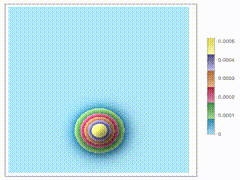My 2 cents on it is that in QM (be it "standard" QM or QFT) one describes only the state of a particle. Having said that, the most general state for a single particle is indeed a wave packet.
Now, if you localise certainly a particle at some point in time, then later on it will be associated with a spreading wave packet because of Heisenberg indeterminacy principle exactly as you say.
The point is then to figure out how long it will take for the wave packet to spread when compared to the time scale of interest.

In the gif above what you can see is that although we start from a quite localised packet the packet eventually spreads because of the momentum dispersion. However, we see it actually "bounces on the walls" like a classical particle would for quite some time after which it spreads entirely in the box.
Even when taking quite ridiculous constraints on the precision, you will find that a well localised atom for example will spreads over a distance of the order of meter in few microseconds while a pebble will spread over a distance of one millimetre over a period of time much bigger than the age of the universe.
EDIT 1: In reaction to ACuriousMind's answer that focuses on the description of particles from the point of view of the quantisation of free fields (and therefore as making sense only as asymptotic states in any interacting system), I would tentatively claim that choosing asymptotically free states is one limiting case that leads to a non ambiguous formal description of a single particle state. I would however argue that a perfectly bound state (like the ground state of a hydrogen atom or even a particle in a box) would, in principle, be equally valid to talk about a particle state. I would say that qualifying those states of an interacting QFT model that can be matched onto states of an equivalent single particle in QM (with the same intrinsic parameters) in a potential as being single particle states for instance seems to be an equally legitimate choice to talk about single particle state. Of course, not all possible states would necessary qualify for such a terminology and one may prefer the term "resonances" to talk about these borderline cases, as discussed in one of ACuriousMind's comment.
EDIT 2: I just remarked that the OP's question is not so much about "classicality" for there are classical variants of a problem with no particle ontology. This is the case of the $\phi^4$ model and also of electromagnetism that does not have any photon classically. I therefore conclude that the original question refers to the existence of local "beables" (to use Bell's terminology) which are localised particle states. From a theoretical and experimental point of view, I think it is worth looking at what has been done in quantum optics where single photon wave packets play an important role (in optical cavities for example. This reference seems to be quite related to the matter https://www.weizmann.ac.il/chemphys/dayan/notes/Lecture3.pdf .

